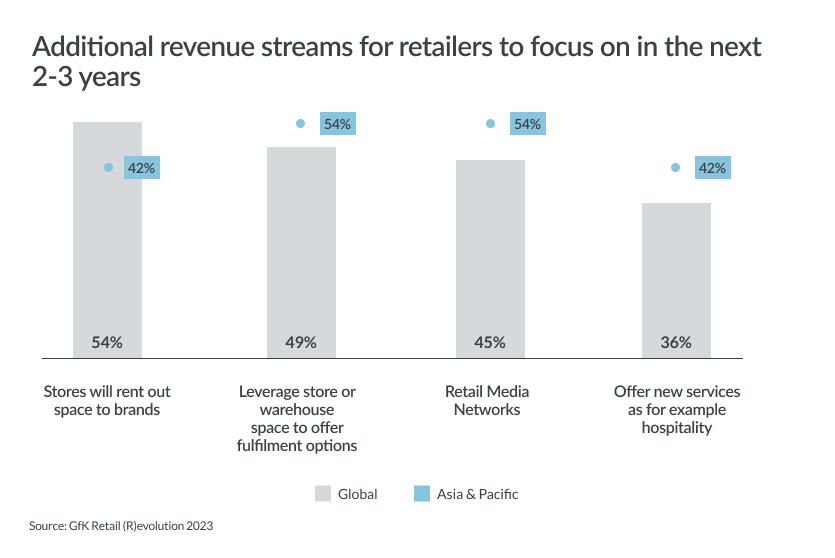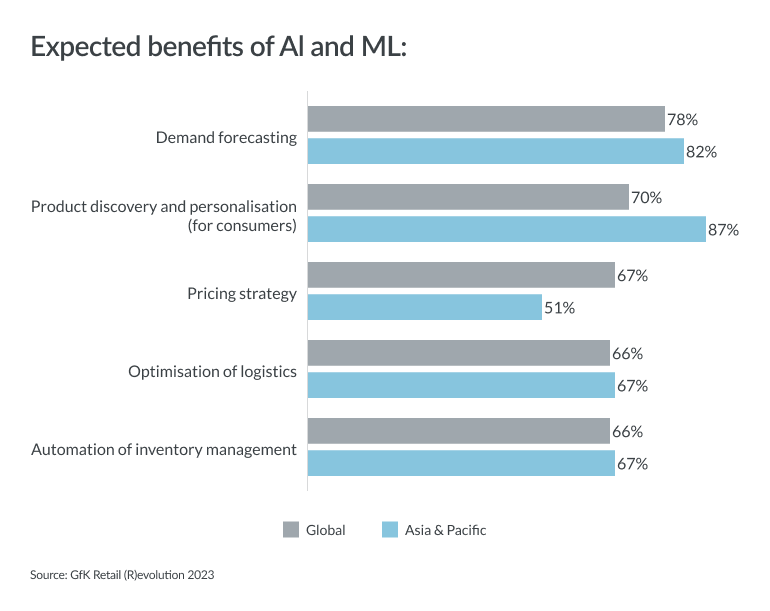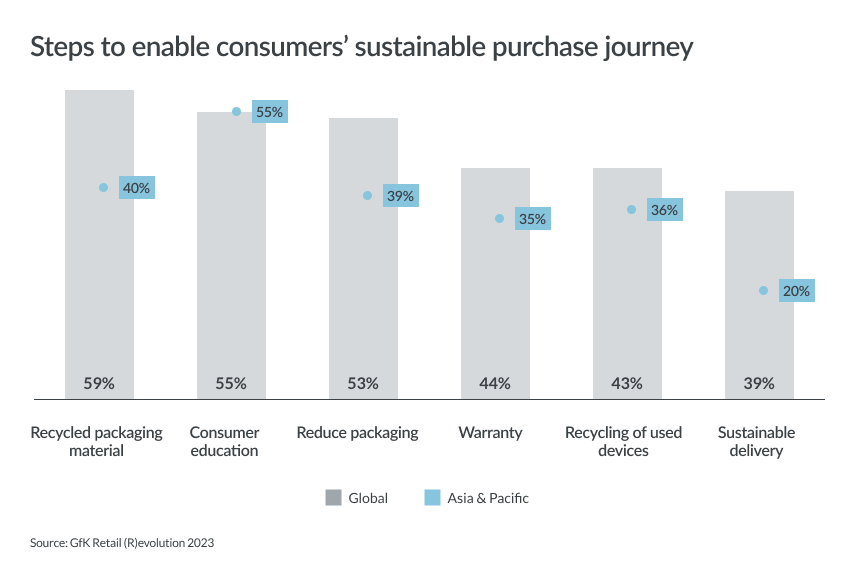Mobile commerce, artificial intelligence and augmented reality, fast delivery, workforces and sustainability all on the agenda
Consumer tech retailers in Asia-Pacific (APAC) are making important investments in response to their divergent challenges and opportunities.
Retail revolution: opportunities being harnessed in APAC
Formats
Strong expectations for mobile and social commerce, and seamless omnichannel sales
Technology
Artificial intelligence & augmented reality to transform personalization and experiences
Operational Excellence
Delivery and payments in a sharp focus, alongside retail media networks
Purpose
Increasing endeavors around sustainable products and consumer education
A new survey by GfK shows retailers focusing on four main interconnected areas: formats, technology, operational excellence and purpose.
The global survey, involving nearly 800 retail executives in 76 countries, reveals fascinating developments in what matters most to retailers across APAC in 2023. The regional results encompass Australia, Azerbaijan, Burma, Cambodia, China, Hong Kong, India, Indonesia, Japan, Kazakhstan, Macau, Malaysia, New Zealand, Pakistan, Philippines, Singapore, South Korea, Taiwan, Thailand and Vietnam.
Across the APAC region, increasingly seamless omnichannel models are in focus. Companies are keen to offer consistent and memorable experiences to customers switching between online and offline browsing and purchasing options. Mobile commerce is of great interest as part of this, with nearly seven in 10 retailers focused on efforts here. Meanwhile, more retailers in APAC than almost any other region have an eye on social commerce, to engage consumers and enable sales.
6 in 10
APAC executives see strong potential for social commerce
87%
say personalization is core benefit of their AI investment
77%
improving their payment services
Over half
looking to offer greener products
Source: GfK Retail (R)evolution 2023
Internally, APAC retailers have a strong focus on improving their processes. Around three quarters are looking to offer better delivery times and a broader product assortment. The ecosystems of services they offer are also a significant consideration. There is an above average prioritization of payments and retail media networks, too, alongside a growing emphasis on enhancing in-store experiences.
Technology will underpin many of the changes retailers are making, especially for the largest players able to invest extensively. Artificial intelligence and machine learning (AI and ML) are high on many of their agendas. Those technologies will advance consumer-facing product discovery and personalization, as well as demand forecasting and inventory management.
At the same time, APAC retailers have a notably level of interest in augmented and virtual reality. In the longer term, these technologies could enable ever more engaging online and in-store experiences.
The issue of sustainability, meanwhile, is an increasingly important one for APAC consumers. Many of the region’s retailers are only making early efforts on sustainable products and practices but interest levels are rising. Consumer education will be key to helping raise demand.
For consumer tech retailers across APAC, a strong understanding of all these dynamics is critical. Then, making the right investment choices offers a powerful opportunity to build profitability and sharpen competitive edge.
APAC: most successful formats expected
69%
omnichannel
64%
mobile commerce
63%
internet marketplace
63%
omnichannel
61%
mobile commerce
59%
buy online, pick up in store
Source: GfK Retail (R)evolution 2023
Formats
Consumer tech retail formats are evolving quickly across APAC.
Retailers anticipate strong growth in mobile commerce, as post-pandemic consumers increasingly check and buy products on their devices.
Mobile and social commerce
Mobile commerce growth in APAC is reflective of total digital activity. In South Korea and China, e-commerce accounts for over half of all retail activity, with mobile a central element. Mobile commerce is also critical in India, as device-based payments become commonplace. Japan and Taiwan, meanwhile, are witnessing growing mobile and online sales.
“Since the Covid pandemic, there’s been a revolution in terms of the education of consumers around online and mobile commerce,” says Reza Rahtomo, retail partnership lead for Singapore at GfK. “Consumers now see mobile as being an effective way of finding the right deals.”
Social commerce is growing, most notably in China with innovative live streaming during sales
Social commerce is also growing strongly, with 61% of APAC retailers confident in its potential, well above global averages. In China, the prominence of influencers and innovative livestreaming strategies has led to a social commerce boom, with sales growth rates nearly doubling each year. Growth is expected in south east Asia, too, where TikTok is becoming ever more popular.
Growing omnichannel focus
Two-thirds of APAC retailers see strong potential for omnichannel sales.

Monjur Elahi, managing director for Malaysia, Indonesia and Philippines at GfK, says omnichannel is playing out in different ways by market. “In China and South Korea, some of the big players have an increasingly seamless experience between major online and offline formats,” he notes. “In south east Asia, it will often be more about click and mortar – simply having a strong online and offline presence.” In India, too, retailers are increasingly investing to reach customers better through a variety of digital channels, in ways that are harmonious with their established bricks-and-mortar stores.
Other vital formats for APAC retailers include internet marketplaces, which are becoming increasingly prominent in the region, as brands look to sell in new spaces online and broaden product assortment. Nearly two thirds of APAC retailers are set to invest here, as they face competition from pure marketplace specialists.
Meanwhile, shopping experience stores are becoming increasingly popular among retailers post-Covid. These offer quality services and tech-enabled immersive experiences.
“Following the pandemic lockdowns, a lot of consumers in APAC have been really enjoying shopping in store again,” notes Elahi. “So retailers are aiming to offer more of these memorable experiences.” These interactions, including through education and hospitality, are particularly important in markets such as China where in-store sales remain critical for higher priced products.
Nurturing relationships with manufacturers
In line with global averages, around a third of APAC retailers are concerned about brands’ direct sales, with some manufacturers releasing flagship or premium products on their own websites first. However, nearly 40% are unconcerned, partly because direct sales’ market share remains modest in most countries, and retailers retain significant weight in the relationship.
Optimism here is furthered by retailers’ confidence around innovative business models. For physical stores, these include offering brands fulfillment options in their shopping and warehouse space, which over half are developing. Meanwhile, four in 10 will rent out store space so brands can offer their own distinct in-store experiences. These engaging consumer interactions, particularly in fast-changing markets such as India, China and Japan, are critical for brands.
In addition, a high 54% of APAC retailers polled by GfK are investing in the development of retail media networks (RMNs). These enable brands to rent space on those retailers’ digital platforms, while deriving powerful insights into customer behavior. RMNs are gaining important ground in all major markets as brands see opportunities to better reach and understand customers.
APAC: top tech focus areas
54%
AI/machine Learning
40%
augmented/virtual reality
30%
blockchain
Source: GfK Retail (R)evolution 2023
Technology
APAC retailers have several strong technology focus areas, which will underpin their format changes and broader operational improvements.
As is the case globally, the strongest focus is on artificial intelligence and machine learning (AI and ML), with robotics increasingly central to the most advanced retailers. Interest in augmented and virtual reality is also particularly high.
AI for personalization
Most APAC retailers plan to invest in AI and ML, the GfK survey shows. The vast majority expect to improve core consumer-facing aspects of their operations as a result, with nine in 10 targeting personalization and product discovery.
“We’re seeing a particularly strong move toward personalization by the big retailers – but given costs and complexity it’s still in the developing stages,” Elahi notes. In China, larger retailers already use AI for extensive personalization, and smaller counterparts are following suit.

Over time, investments in AI-driven personalization will become critical, as more retailers seek to ensure they build customer loyalty through offering relevant products and experiences. Interpreting a sea of data, and then being able to respond rapidly, will be key. In markets such as India, many retailers are considering AI as a longer term play, as use cases and likely return on investment become clearer.
AI will play an important role in product discovery, too, as online players holding a huge array of goods look to improve how consumers can quickly find the right items.
Managing demand, stock and warehousing
For those retailers able to invest, AI will play a critical role in interpreting demand signals early, ensuring retailers can hold the right stock, and making sure they can supply it quickly to consumers. As part of this, four in 10 of APAC retailers investing in AI are seeking to to improve demand forecasting.
Since the Covid pandemic, in the face of stiff economic headwinds, stock management has also been challenging for retailers of all types, with many urgently having to improve how they manage warehousing amid sudden product surpluses and shortages. As a result, over two thirds of APAC retailers investing in AI plan to automate inventory management and to optimize logistics.
Augmented and virtual reality have longer term potential as differentiators for APAC retailers
At the same time, robotics will take an increasing role in warehouse automation. One quarter of APAC retailers are considering investing here – an important niche “Many retailers are holding back due to the costs, but they can see large competitors increasingly using robots to automate warehouse processes,” Rahtomo explains.
In China, smaller retailers are indirectly using robotics here, by paying larger automated counterparts to handle their fulfillment. Meanwhile, an array of Japanese retailers are increasingly turning to warehouse automation to unlock efficiencies.
Experience transformation
Retailers in APAC also have well above-average interest in two technologies that may transform customer experience.
Investments in augmented reality and virtual reality (AR and VR) are being targeted by four in 10 APAC retailers. The technologies can empower consumers in every area from remote product tryouts to immersive in-store experiences.
The high interest levels here are attributable to consumers’ strong digital maturity and widespread familiarity with emerging technologies. Mobile-first experiences, and almost entirely unmanned physical stores, are increasingly prevalent in advanced markets such as China and South Korea. In these jurisdictions, it may prove a natural step for retailers to add in AR and VR technologies.
At the same time, for the majority of retailers, AR and VR remain aspirational rather than a short-term reality – given budgetary pressures. “We’re not there yet,” Rahtomo notes, “but in the long term, AR and VR definitely have potential as a point of differentiation.”
APAC: operational focus areas
78%
delivery
78%
supply chain
77%
payments
73%
workforce and talents
Source: GfK Retail (R)evolution 2023
Operational Excellence
Across APAC markets, consumer tech retailers are set to invest extensively in fundamental operational areas. These will enable new services and revenues, and support efficiency.
Priorities will include delivery times, supply chains and payment services. These will be critical as the region’s retailers pursue an above average expansion of their service ecosystems. Tech will be crucial – alongside workforce and talent development, a key focus area for three quarters of retailers.
Delivery times on the agenda
Nearly eight in 10 APAC retailers will invest to improve deliveries.
The most notable advancements are in some of the most developed cities, such as in Shanghai and Beijing, where large retailers deliver to city-based customers’ homes in a matter of hours. In India, quick service retailers are also able to deliver to homes in hours or less, in areas of the largest cities. In Japan, similar changes are beginning, but laws limiting drivers’ working hours are expected to pose challenges. By contrast, in more developing markets such as Malaysia and Indonesia, consumers expect deliveries to arrive within several days, owing to challenges around transport infrastructure and the vast distances between cities.
There is an above average focus on payments, including connecting to multiple providers and offering installments
Managing supply chains better is also a critical element here, and it is a focus for 78% of APAC retailers, in line with global averages. While 2023 has seen some recovery from Covid-era challenges, oversupply and shortages remain common. AI technologies will help ensure a broad range of popular products are available consistently, better matching demand.
Broadening payment services
In APAC, a notable 77% of retailers, far above global averages, are focused on expanding the payment methods available to consumers. In practice, this will see retailers connecting to an increased number of international and loyal payment providers, and offering longer payment terms. “From a consumer experience perspective, people want seamless interactions, and payments are a critical part of that picture,” explains Elahi.
Offering the option to pay for products in installments is also becoming a clear focus for some retailers, partly in response to inflationary pressures and affordability concerns among consumers. These services may be provided in house or by credit firms.
Some of these are also directly geared towards those with limited banking access. Much of the strongest growth in installment offerings is in Malaysia and the Philippines – as well as India and Indonesia, where zero or near-zero interest rates are available.
Critical workforce investments
In order to enable these operational changes amid a budgetary squeeze, retailers across the APAC region are making important choices around their workforces and technology deployments. According to the GfK survey, some 73% plan to spend on improving or expanding their workforce.
“Across stores there is now a scarcity of resources in terms of sales reps and other roles, so retailers are really examining how to improve staffing,” Elahi notes. “At the same time, with all the pressures on margins, there will be some tough choices around how and where to hire.”
In areas where staff are most critical to services, such as on the shop floor, human investments are most likely to be augmented. Smaller retailers will also invest in resources to offer local services, such as installation, as is being witnessed in China. By contrast, in areas of repeatable or back office processes, retailers may focus instead on employing technology experts to drive automation.
APAC: purpose focus areas
55%
sustainable products and
services
45%
sustainable internal
practices
40%
repair hubs
27%
second-life products
Source: GfK Retail (R)evolution 2023
Purpose
In APAC, as globally, consumer expectations of retailers are rising.
GfK research shows that preserving the environment has risen to become a top 20 personal value for consumers in developing Asia, with its importance growing markedly across developed markets. Increasingly, people want brands and businesses to offer a clear sense of purpose.
However, there is a notable difference between expectations and retailer investment. For retailers not investing in sustainability, over half say consumers do not demand it.
More sustainable retailers are now picking up customers’ unwanted boxes at delivery, which can also build loyalty
“There’s definitely a bit of a gap between what regulators and governments want to do, and what retailers are actually doing,” Elahi notes. “For example, with refrigerators, the price difference is high between eco and non-eco options, and they know many people will choose the cheaper one.” For many retailers, such as in India, being more eco and supporting ethical causes in their markets is helping build their brand and develop customer loyalty.
Growing sustainability
In spite of this, there is still notable growth in retailer investments around sustainability, particularly when it comes to the right products and services. Here, some 55% are set to invest, and this will partly involve offering greener items, often at a premium.
As a result, large retailers are promoting the most efficient appliances, such as greener refrigerators, to more affluent consumers. The focus is typically on the ultimate lower costs of operation.
Meanwhile, nearly half of APAC retailers will invest in making their internal practices more sustainable. This will involve less energy usage and reduced waste. And four in 10 of the region’s retailers are looking at using more recycled packaging, or reducing packaging overall.
“We’re even seeing some retailers picking up the boxes from people they’ve delivered products to,” Rahtomo notes. “It shows people that they care as a retailer, which can go a long way.”
Repair services and second life products
Across APAC, there is also a notable swath of retailers aiming to keep devices working for longer, also critical as consumers look to save money.

Four in 10 APAC retailers will invest in repair hubs, slightly above the global average. By offering device repair in-store, retailers with a strong bricks and mortar presence can help consumers keep their devices running for longer, without simply replacing them. These efforts also present opportunities to bring consumers back in store.
Another area of note is second life products. The 27% of retailers investing here represents a notable niche. Among the challenges for APAC retailers is the fact that refurbished products are not always much cheaper to buy than new ones, and consumer concerns over device lifespan can persist.
“Unlike in Europe where more retailers might offer refurbished products, that’s something many APAC retailers shy away from,” Rahtomo notes. “It is picking up momentum though, along with broader sustainability.”
Among active retailers here are large Japanese chains, which buy used devices from consumers, and sell them refurbished.
Recycling rates in general are below global averages, too. However, in markets such as New Zealand and Australia there is a growing emphasis on laws and incentives around recycling devices and appliances, which means fewer tech products end up in landfill.
As a whole, consumer education will be an important part of sustainability progress. With 55% of retailers investing in education, it is a major contributor to consumers’ sustainable purchase journeys. This is already being witnessed in developed markets such as China, Japan and Singapore where consumer education efforts are most widespread and are changing mindsets.
Conclusion
In countries throughout APAC, consumer tech retailers are planning significant changes. Transformations across formats, technology, operations and purpose will all be critical in delivering the right products at the right times, capturing sales across multiple channels, and deepening customer loyalty.
While the challenges and opportunities differ significantly between markets, APAC retailers have a consistent and clear focus on mobile formats. Social commerce and augmented reality, in more affluent markets, will also be key elements of omnichannel strategies. A sharp focus on personalization, and offering ever more accessible and flexible payment methods, can also help grow revenues and deliver memorable experiences.
The region’s retailers will aim to keep manufacturers close with a powerful use of in-store space for fulfillment and for brand zones, as well as digital retail media networks to help drive online traffic and offer hugely valuable behavioral insights.
Amid heavy pressure on margins, APAC retailers are also targeting major operational improvements. Faster delivery will be a fundamental aim throughout, with ultra fast provision already targeted in major cities. These advancements will require significant workforce expansion and training, as well as the use of AI and ML technologies that help smooth supply chains, predict demand and manage stock.
Across the region, consumers also increasingly want to buy from purposeful businesses. There remains a gap between these expectations and retailers’ investments, but there is a growing momentum towards the provision of sustainable products and services. Many retailers are also working to reduce waste and improve recycling.
Looking ahead, the APAC retailers investing wisely in the four pillars of formats, tech, operations and purpose will be those best placed to succeed. Many already rely on GfK insights and consulting to understand local trends, and to make the right moves.
Authors

Namrata Gotarne
Global Strategic Insights

Ines Haaga
Global Strategic Insights
Contributers

Reza Rahtomo
Retail partnership lead for Singapore at GfK

Monjur Elahi
Managing director for Malaysia, Indonesia and Philippines at GfK

Ushpreet Bawa
Senior director at GfK

Junichi Mizumura
Research group manager for Japan at GfK

Howard He
Head of retailer services for China at GfK
Endorsed by

Michael McLaughlin
President Global Retail

Wolfgang Wanders
VP MI Product

Vishal Bali
Global VP CSM

Jamie Clarke
Head of North America Retail NIQ





